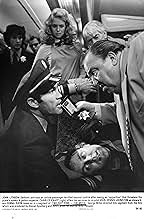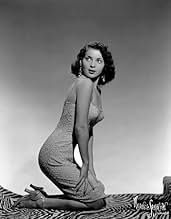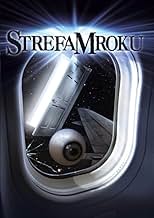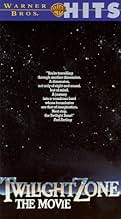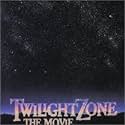IMDb-BEWERTUNG
6,5/10
43.401
IHRE BEWERTUNG
Vier Horror- und Science-Fiction-Segmente unter der Regie von vier berühmten Regisseuren, die jeweils eine neue Version einer klassischen Geschichte aus Rod Serlings bahnbrechender Fernsehse... Alles lesenVier Horror- und Science-Fiction-Segmente unter der Regie von vier berühmten Regisseuren, die jeweils eine neue Version einer klassischen Geschichte aus Rod Serlings bahnbrechender Fernsehserie darstellen.Vier Horror- und Science-Fiction-Segmente unter der Regie von vier berühmten Regisseuren, die jeweils eine neue Version einer klassischen Geschichte aus Rod Serlings bahnbrechender Fernsehserie darstellen.
- Auszeichnungen
- 1 Gewinn & 8 Nominierungen insgesamt
Rainer Peets
- German Officer (segment "Time Out")
- (as Remus Peets)
William S. Taylor
- G.I. (segment "Time Out")
- (as William B. Taylor)
Empfohlene Bewertungen
An affectionate homage to the old TV series. Three old episodes were updated and a new one was written. It's also narrated by Burgess Meredith who starred in quite a few of the original TV series episodes.
It starts off with a quick little prologue with Albert Brooks and Dan Aykroyd. It's quick, funny and provides a nice little jolt.
The first segment was newly written for the movie. It involves a bitter and racist man (Vic Morrow) getting a taste of his own medicine. This episode is clouded by the three deaths it caused--Morrow was decapitated by a helicopter blade and two Vitenamese children were crushed. John Landis (who directed this) was found not guilty in the deaths. As it stands this isn't very good. It's simplistic and heavy-handed--like a bad Zone episode.
The second one is directed by Steven Spielberg. It involves an old man (Scatman Crothers) gently bringing to life the old people at a retirement home. I'll be the first to admit that this is way too syrupy--but I have a fondness for it. The acting is good, it has a great music score and, I admit, it leaves me a little misty-eyed.
The third is directed by Joe Dante. It's a remake about a little boy who can make all of his wishes come true. It's well-directed with some truly incredible special effects and a good performance by Kathleen Quinlan. But it's seriously damaged by a silly happy ending (the original didn't have that). Billy Mumy (the star of the original) has a bit part and Dante regular Dick Miller shows up as Walter Paisley.
The fourth is the best. It's directed by George Miller and is a remake of the William Shatner episode where he spots a gremlin tearing apart the plane he's flying on. The gremlin in the original looked pretty ridiculous--like a teddy bear. Here John Lithgow plays the passenger and the gremlin is more than a little scary-looking. This segment moves and has a few great jolts. Also Carol Serling (Rod Serling's wife I believe) has a bit part.
All in all an enjoyable film. I liked it when I saw it in a theatre in 1983 and it still holds up today. I give it an 8.
It starts off with a quick little prologue with Albert Brooks and Dan Aykroyd. It's quick, funny and provides a nice little jolt.
The first segment was newly written for the movie. It involves a bitter and racist man (Vic Morrow) getting a taste of his own medicine. This episode is clouded by the three deaths it caused--Morrow was decapitated by a helicopter blade and two Vitenamese children were crushed. John Landis (who directed this) was found not guilty in the deaths. As it stands this isn't very good. It's simplistic and heavy-handed--like a bad Zone episode.
The second one is directed by Steven Spielberg. It involves an old man (Scatman Crothers) gently bringing to life the old people at a retirement home. I'll be the first to admit that this is way too syrupy--but I have a fondness for it. The acting is good, it has a great music score and, I admit, it leaves me a little misty-eyed.
The third is directed by Joe Dante. It's a remake about a little boy who can make all of his wishes come true. It's well-directed with some truly incredible special effects and a good performance by Kathleen Quinlan. But it's seriously damaged by a silly happy ending (the original didn't have that). Billy Mumy (the star of the original) has a bit part and Dante regular Dick Miller shows up as Walter Paisley.
The fourth is the best. It's directed by George Miller and is a remake of the William Shatner episode where he spots a gremlin tearing apart the plane he's flying on. The gremlin in the original looked pretty ridiculous--like a teddy bear. Here John Lithgow plays the passenger and the gremlin is more than a little scary-looking. This segment moves and has a few great jolts. Also Carol Serling (Rod Serling's wife I believe) has a bit part.
All in all an enjoyable film. I liked it when I saw it in a theatre in 1983 and it still holds up today. I give it an 8.
Five episodes realized as tribute to Rod Serling's Twilight zone, made by four known directors . It's is divided into 4 parts , three of them real remakes from classic television series, though starts in a prologue stars Albert Brooks and Dan Aykroyd . The best directed by John Landis is the first, where a bigot (played by Vic Morrow who died during filming by a helicopter crash accident) who becomes pursued of evil Nazis, Ku Klux Klan and American soldiers in Vietnam. The second segment directed by Steven Spielberg is a silly story about old people living in a retirement house who turn into little boys, thanks a strange visitor (Scatman Crothers). The third directed by Joe Dante concerns about a young woman (Kathleen Quinlan) encounters a kid with rare powers and some people (Kevin McCarthy, William Schallert,among them) closed at a strange house. And fourth episode titled 'Nightmare at 20.000 Feet' deals with a terrified passenger(John Lightow) who watch a creepy monster making rare issues on the wing of the plane.
The picture contains good special effects in traditional style without excessive computer generator as usual nowadays. The master Jerry Goldsmith composes a magic musical score particularly reflected on the second episode titled 'Kick the can' . Colorful and imaginative cinematography especially in the third segment titled 'It's a good life'. Rating : Acceptable and passable, the picture will appeal to fantastic genre buffs.
The classic long-running television series is formed by 156 episodes and its narrator , of course, Rod Serling. Later on, in 2002 are realized 44 new episodes with Forest Whitaker as host.
The picture contains good special effects in traditional style without excessive computer generator as usual nowadays. The master Jerry Goldsmith composes a magic musical score particularly reflected on the second episode titled 'Kick the can' . Colorful and imaginative cinematography especially in the third segment titled 'It's a good life'. Rating : Acceptable and passable, the picture will appeal to fantastic genre buffs.
The classic long-running television series is formed by 156 episodes and its narrator , of course, Rod Serling. Later on, in 2002 are realized 44 new episodes with Forest Whitaker as host.
"Twilight Zone: The Movie" is a mostly entertaining anthology film based on Rod Serling's classic TV series of the 1960s. Four bizarre tales are told through the minds of four different filmmakers: John Landis, Steven Spielberg, Joe Dante, and George Miller (Landis and Spielberg also produced). "Twilight Zone: The Movie" starts with a brief prologue starring Dan Aykroyd and Albert Brooks. Then comes segment #1, directed by Landis. This is the part of the movie that made headlines around the world when a freak accident killed actor Vic Morrow and two children while shooting a helicopter scene (which is not seen in the film). This story is about an angry man (played by Morrow) who is not happy with America because of all the different races that are living in the country. Then something strange happens. When the man steps outside of a bar, he finds himself on a street in Nazi Germany; a few minutes later he's confronted by the Klu Klux Klan; then he discovers he's in the middle of the Vietnam War; and so on. As for how this segment goes, it's only so-so. However segment #2, directed by Spielberg, is the weakest story of the bunch. Scatman Crothers stars as an elderly man who comes to live at a retirement home. After making friends with some of the elderly people living there, he talks them into playing a spirited game of kick the can. This is no ordinary game. Let's just say that its a game with a fountain of youth twist to it. I found this segment real boring. Up to this point, "Twilight Zone: The Movie" is disappointing. But then the film picks up with the strong last two segments. Segment #3, directed by Dante, stars Kathleen Quinlan as a woman who meets a little boy after accidentally knocking him off of his bike with her car. She decides to give the boy a ride home. But this is no ordinary home. It's a house where every TV set has a cartoon on, and the boy's family act like a bunch of crazy people (like their cartoons themselves). Quinlan begins to realize that this kid is not normal. This segment works because it's creepy (the look of the house on the inside is fascinating) and funny (every member of the kid's family is a complete nut). Ah, but the best segment comes last. Segment #4, directed by Miller, is a truly scary tale starring John Lithgow (from TV's "3rd Rock From the Sun") as a terrified passenger of an airplane flying through a severe thunderstorm. Things get worse when Lithgow see's something on the wing of the plane. What is it? A man? Or is it a monster? This segment literally had me on the edge of my seat. It's an excellent finale to "Twilight Zone: The Movie". So my advice is skip the first two segments, but watch the last two.
Here's my separate ratings for each segment (out of four stars):
Segment #1: **1/2; Segment #2: *1/2; Segment #3: ***1/2; Segment #4: ****
This adds up for an estimated combined rating of *** stars.
Here's my separate ratings for each segment (out of four stars):
Segment #1: **1/2; Segment #2: *1/2; Segment #3: ***1/2; Segment #4: ****
This adds up for an estimated combined rating of *** stars.
It is very hard to think of another film anywhere that had such a great potential as TWILIGHT ZONE: THE MOVIE had, only to have a senseless and totally preventable tragedy--the deaths of actor Vic Morrow and two illegally hired Asian child actors--mar the impact. Aside from that, and some heavy-handed moralizing that even the original show's creator Rod Serling would have had problems with, this is a fairly good tribute to what was perhaps the best TV series in history.
The prologue (with Dan Aykroyd and Albert Brooks) and Segment 1 are both originals, written and directed by John Landis. The segment deals with a very embittered white man (Morrow) who, after being dealt the denial of a promotion at work in favor of a Jew, unleashes his bigotry at a bar. But when he steps outside, he soon gets a dose of his own bitter medicine: persecution by the Nazis in Vichy France circa 1943; stalked by the KKK in Alabama in 1956; attacked by US soldiers in Vietnam circa 1969. Landis' penchant for hamfisted dialogue and erratic direction dilute what could have been an effective piece; and the tragedy that occurred on his watch taints not only this segment but much of the rest of the movie.
Segment 2, a remake of the 1961 episode "Kick The Can", directed by Steven Spielberg, stars Scatman Crothers as an elderly magician who brings a sense of youth to the residents of a senior citizens home, though over the objections of a veritable old fuddy-duddy (Bill Quinn). Spielberg has often been attacked, mostly unnecessarily, for his tendency toward sloppy sentimentality, but here a lot of the attacks may be justified, despite the best of intentions. He is still my favorite director, but this is one of his weakest.
Segment 3 remakes "It's A Good Life." Under the inventive hands of director Joe Dante (THE HOWLING), this film stars Jeremy Licht as a boy with the power to enslave and terrorize his family when he comes to feel that they hate him. Kathleen Quinlan stars as the teacher who unintentionally gets caught up in the melee, only to wind up volunteering to teach Licht how to better use his powers before they become too big for him to control (a la CARRIE). Dante's use of inventive special effects (courtesy of Rob Bottin) and black comedy enliven this segment, despite some weird overacting from the rest of the segment's cast (including William Schallert and Kevin McCarthy).
Segment 4 is a reworking of the famous episode "Nightmare At 20,000 Feet." With George Miller (MAD MAX) at the director's helm, the segment stars John Lithgow as an incredibly anxious passenger with a morbid fear of flight who constantly sees a monstrous gremlin tearing apart at the wings of his plane during a severe storm. His anxiety explodes into terror and madness, and the other passengers think he is certifiable. But when the plane lands, and the damage is inspected...
The final score on this is that Landis and Spielberg, who also produced, come up with the weaker segments, and Dante and, especially, Miller come up with the best ones. Miller's segment is a truly kinetic piece of suspense and terror, though I did find the little girl (Christina Nigra) an extremely obnoxious and unnecessary presence. Lithgow, who takes over for William Shatner (who had the role in the TV episode), gives a bravura performance, arguably paving the way for his role in "2010" as an astronaut deftly afraid of heights.
Jerry Goldsmith's usual efficient score and some good special effects work help to make TWILIGHT ZONE: THE MOVIE not only an above-average tribute to a great TV show, but also a good anthology film that combines fantasy, suspense, and mystery. It is a shame that the film is tainted by a pointless tragedy. But if one can ignore that, there are rewards to be had by seeing this.
The prologue (with Dan Aykroyd and Albert Brooks) and Segment 1 are both originals, written and directed by John Landis. The segment deals with a very embittered white man (Morrow) who, after being dealt the denial of a promotion at work in favor of a Jew, unleashes his bigotry at a bar. But when he steps outside, he soon gets a dose of his own bitter medicine: persecution by the Nazis in Vichy France circa 1943; stalked by the KKK in Alabama in 1956; attacked by US soldiers in Vietnam circa 1969. Landis' penchant for hamfisted dialogue and erratic direction dilute what could have been an effective piece; and the tragedy that occurred on his watch taints not only this segment but much of the rest of the movie.
Segment 2, a remake of the 1961 episode "Kick The Can", directed by Steven Spielberg, stars Scatman Crothers as an elderly magician who brings a sense of youth to the residents of a senior citizens home, though over the objections of a veritable old fuddy-duddy (Bill Quinn). Spielberg has often been attacked, mostly unnecessarily, for his tendency toward sloppy sentimentality, but here a lot of the attacks may be justified, despite the best of intentions. He is still my favorite director, but this is one of his weakest.
Segment 3 remakes "It's A Good Life." Under the inventive hands of director Joe Dante (THE HOWLING), this film stars Jeremy Licht as a boy with the power to enslave and terrorize his family when he comes to feel that they hate him. Kathleen Quinlan stars as the teacher who unintentionally gets caught up in the melee, only to wind up volunteering to teach Licht how to better use his powers before they become too big for him to control (a la CARRIE). Dante's use of inventive special effects (courtesy of Rob Bottin) and black comedy enliven this segment, despite some weird overacting from the rest of the segment's cast (including William Schallert and Kevin McCarthy).
Segment 4 is a reworking of the famous episode "Nightmare At 20,000 Feet." With George Miller (MAD MAX) at the director's helm, the segment stars John Lithgow as an incredibly anxious passenger with a morbid fear of flight who constantly sees a monstrous gremlin tearing apart at the wings of his plane during a severe storm. His anxiety explodes into terror and madness, and the other passengers think he is certifiable. But when the plane lands, and the damage is inspected...
The final score on this is that Landis and Spielberg, who also produced, come up with the weaker segments, and Dante and, especially, Miller come up with the best ones. Miller's segment is a truly kinetic piece of suspense and terror, though I did find the little girl (Christina Nigra) an extremely obnoxious and unnecessary presence. Lithgow, who takes over for William Shatner (who had the role in the TV episode), gives a bravura performance, arguably paving the way for his role in "2010" as an astronaut deftly afraid of heights.
Jerry Goldsmith's usual efficient score and some good special effects work help to make TWILIGHT ZONE: THE MOVIE not only an above-average tribute to a great TV show, but also a good anthology film that combines fantasy, suspense, and mystery. It is a shame that the film is tainted by a pointless tragedy. But if one can ignore that, there are rewards to be had by seeing this.
When I first watched this film at the age of seven, I must have been freaked out for weeks. Never had a movie had that kind of effect on my psyche, especially "Nightmare at 20,000 Feet." While some will label this as a bad film due to the fact it didn't faithfully reproduce the original stories very well. I say 'Who Cares!' Sometimes, fear and entertainment is all that one needs in regard to a cool movie such as this one. While it is certainly not a film that will rank highly in the greatest films of all time category, at least it proved this concept in story telling is pertinent today, even in today's cynical culture.
Wusstest du schon
- WissenswertesThe scene being shot at the time of Vic Morrow's fatal accident was added to the script late in the filming in an attempt to "soften" his bigoted character Bill Connor, and give him some redemption: while fleeing from an American helicopter attack on a deserted Vietnamese village, he sees two orphaned children. Bill decides to save them no matter what the cost, so he carries them under his arms and wades through the river to safety. He then finds himself back in Nazi-occupied France again, the two children having time-jumped with him. The two Nazi officers chasing Bill take the children away for execution, and take Bill to a train which ends the segment. Due to the helicopter accident that claimed the life of Morrow and child actors Renee Chen and My-ca Dinh Le, all scenes featuring the children were completely cut, and they do not appear in the film. Bill's original scripted ending was kept in, leaving Bill's character change largely unaddressed and his fate unknown.
- PatzerAn exterior shot of the airplane in Segment #4 shows the landing gear to be in the down position. The pilot later comments that the plane would be landing in twenty minutes, far too long for gear to be down prior to touchdown.
- Zitate
Car Passenger: Hey... you wanna see something really scary?
- Alternative VersionenCBS edited 8 minutes from this film for its 1986 network television premiere.
- SoundtracksNights Are Forever
Performed by Jennifer Warnes
Music by Jerry Goldsmith
Lyrics by John Bettis
Produced by Bruce Botnick with James Newton Howard
[Segment #1: playing when William enters the bar]
Top-Auswahl
Melde dich zum Bewerten an und greife auf die Watchlist für personalisierte Empfehlungen zu.
Details
- Erscheinungsdatum
- Herkunftsland
- Sprachen
- Auch bekannt als
- Al filo de la realidad
- Drehorte
- 15238 Victory Boulevard, Van Nuys, Los Angeles, Kalifornien, USA(bar in segment #1; exterior & interior)
- Produktionsfirmen
- Weitere beteiligte Unternehmen bei IMDbPro anzeigen
Box Office
- Budget
- 10.000.000 $ (geschätzt)
- Bruttoertrag in den USA und Kanada
- 29.450.919 $
- Eröffnungswochenende in den USA und in Kanada
- 6.614.366 $
- 26. Juni 1983
- Weltweiter Bruttoertrag
- 29.450.919 $
- Laufzeit
- 1 Std. 41 Min.(101 min)
- Farbe
- Sound-Mix
- Seitenverhältnis
- 1.85 : 1
Zu dieser Seite beitragen
Bearbeitung vorschlagen oder fehlenden Inhalt hinzufügen



